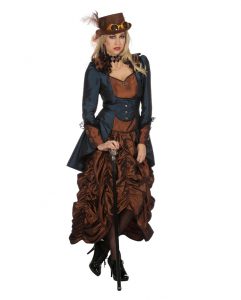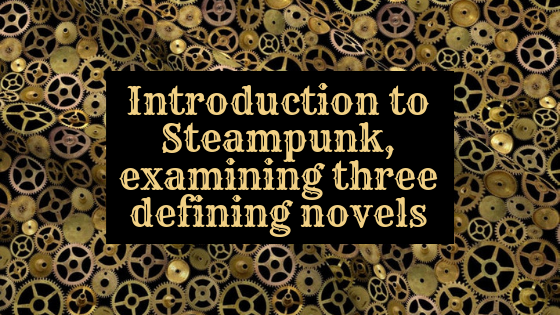I’ve recently fallen in love with the steampunk genre. It offers fun, adventure, fascinating worldbuilding, rich settings, intrepid characters and charming technologies. I cannot claim to be an expert by any means but in this article I will attempt to provide an introduction to the steampunk genre, referring to three novels that epitomise the genre. These novels are:
- Boneshaker by Cherie Priest (2009)
- Mortal Engines by Philip Reeve (2001)
- The Anubis Gates by Tim Powers (1983)
What is Steampunk?
Steampunk is a sub-genre of speculative fiction. I like this definition by steampunk author Phoebe Darqueling:
It began as a literary genre loosely inspired by the real or imagined cultures, events, and technologies of the Industrial and Victorian eras (roughly speaking the 19th century, but there’s wiggle room). Steampunk can take various forms, from an alternative history to a dystopian future, to a complete fantasy world untethered to our sense of time and space.
Phoebe Darqueling, ‘The Steampunk Handbook’


Many definitions of steampunk refer to steam-power technology, and airships. However, the novels don’t always contain these, as we will see with The Anubis Gates. It is also difficult to say whether steampunk is fantasy or science fiction. Some books/films lean more one way while some lean the other. As Phoebe says above, it began as a literary genre, but it is now much more than that. There are films and TV shows based on the genre, and there are many fans which attend the many conventions. Fashion is now a big part of steampunk – costumes are gothic-looking with goggles and clockwork accessories.
There are a number of novels that are considered defining works of the steampunk genre. In particular, I like this list of 20 steampunk books compiled by the Ranting Dragon. I chose three books from this list which also appear on other lists of defining steampunk books and read them in the order listed above. I chose the order at random but I’m glad it turned out the way it did. This is because I think they decrease in their ‘steampunkness’ as you descend the list. So I started out with a really good example of the genre and got to an example on the edges.
Book discussion
Before I start, I’ll just say I really enjoyed all three novels and I highly recommend them. I enjoyed the first two the most though, because they are the most ‘steampunkish’, in that they have steam-powered machinery, airships and fun adventurous settings. I recommend that you read them in the order I did; in this way you will get the best introduction to steampunk as you will first be soaked in it and then later you will see how it can be done with a lighter touch.
Boneshaker by Cherie Priest (2009)
This is set in an alternate history in 1880s Seattle, USA. An accident in the town has caused a toxic gas to leak from the ground and the town has been walled in. In this story, a mother has to enter the town to find her son, who went there looking for information about his father. It is packed full of adventure, there are airships, steam-powered machines pumping clean air into the town, zombies (created from the gas) and goggles, breathing equipment – everything you could want from a steampunk novel is in this book. On top of this, there are some great characters and it is FUN without being lame in any way. I can’t recommend it enough.
Mortal Engines by Philip Reeve (2001)
This book is set in a far future after a global war has destroyed civilisation as we know it. In this future, people live on mobile cities mounted on wheels, and they hunt each other and consume each other. The book starts with the city of London hunting a smaller town. This concept alone is enough to sell the book but it gets even more amazing. The story follows a boy who has fallen out of London and is trying to return. There are airships, even an airborne town, a cyborg, fun settings and adventure galore. It’s written for 11-16 year olds but it is fine for adults and, like with Bone Shaker, I can’t recommend it enough.
The Anubis Gates by Tim Powers (1983)
This novel is considered one of the founding works of the steanmpunk genre. It is hugely imaginative and uses time travel as part of the plot. The story follows a specialist on early nineteenth century poets, who is stuck in 1810 after taking a group of time tourists to see a speech in London. He wants to get back to the 1980s. There is lots of magic and adventure, and we venture into the dark London underbelly where we meet some captivating characters. There are beggars, gypsies, even a werewolf. The pace hares along.
That concludes my introduction to steampunk! Do you love the genre? Or are you new to it and going to give it a try? Let me know your thoughts in the comments!



Thanks for this brief, curated list! Been looking for something like this for a while, now.
Have you happened to apply this to the cyberpunk genre?
Hi Chris Thank you so much for your comment! I haven’t done this for the cyberpunk genre yet but that’s a really good idea, and something I think I will do in the near future. In the meantime, you can read my post on Neuromancer, the seminal cyberpunk novel by William Gibson. I examine the novel from a writer’s point of view and pull out some writing tips, but it’s great reading and informative even if you’re not a writer. You can read it at https://sffdirect.com/essential-writing-tips-neuromancer
Caroline.